Do you have a job that requires you to be on your feet all day? Does it feel like your soles are slipping and sliding about no matter what socks or shoes you’re wearing? This blog article may assist if you’ve been struggling with this issue for weeks, months, or even years. We’ll talk about how to make shoes non-slip for work in this post.
The best methods for making work shoes non-slip seem to be grip pads or scuffing the soles with sandpaper. We have, however, also tried alternative techniques to create shoes slip-resistant for the workplace. So be sure to finish reading this manual.
Also Read: Are Converse Skate Shoes Good
How Could Slip-Resistant Shoes Threaten Your Safety?
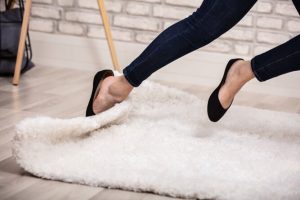 The most frequent reasons for injuries at work, including in restaurants, hospitals, industries, and veterinary clinics, are slips and falls. Since requiring employees to wear slip-resistant shoes, a number of organizations have seen some significant accidents.
The most frequent reasons for injuries at work, including in restaurants, hospitals, industries, and veterinary clinics, are slips and falls. Since requiring employees to wear slip-resistant shoes, a number of organizations have seen some significant accidents.
According to statistics provided by the Centers for Disease Control and Prevention, out of a million Americans who have slips and trips, 17000 of them result in fatal injuries. British research estimates that one million days of work are lost each year because of injuries sustained in slips and falls. These statistics make us consider why it has become vital for workplaces to make shoes non-slip.
In between 20 and 30 percent of slip-and-fall incidents, there are serious injuries, such as spinal cord breaks or brain injuries. Over 20,000 deaths a year in North America are caused by slip-and-fall accidents.
It has become necessary to mend slippery shoes in order to effectively function in your individual jobs without any worry of sliding as a result of such unpleasant situations.
How to Make Shoe Non-Slip for Work
Let’s have a look at some of the best methods and ideas you can use to give your shoes more traction and prevent slipping.
Scrubbing the outsoles
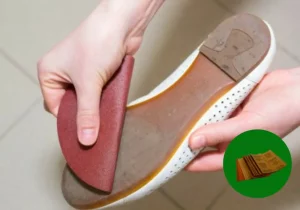 The first characteristics you notice while purchasing shoes are style, comfort, cushioning, fit, and platform height. Under the cloak of those noticeable traits, the most crucial element from the standpoint of safety is concealed. Since most shoes have a polished surface when they are new, their rubber soles tend to be smooth and slick.
The first characteristics you notice while purchasing shoes are style, comfort, cushioning, fit, and platform height. Under the cloak of those noticeable traits, the most crucial element from the standpoint of safety is concealed. Since most shoes have a polished surface when they are new, their rubber soles tend to be smooth and slick.
Wearing the shoes and walking on hard, rough surfaces like concrete floors or wandering about on uneven, rocky terrain with bumpy rides and full of stones is the easiest method you can use to make the sole slip-proof without using any device or instrument. Such harsh, uneven, and abrasive surfaces wear away the outsole’s smooth polish and tangle of interwoven fibers. They enhance traction to the bottom of the shoes by creating tiny dents on the sole surface.
Also Read: Can Suede Shoes Get Wet
Scrape with sandpaper
Another method to make shoes anti-slip if you don’t walk about for long distances to scratch your sole and worry about sliding is to scrape the bottom of the shoes with medium-grit sandpaper until the sole has a rough textured sensation. In our testing, we found that making the soles tough and non-slip may be accomplished using 50-grit sandpaper.
- To make the soles more slip-resistant, you may use the simple techniques that follow.
- Grab a piece of medium-grit sandpaper. It must be brand-new and have never been touched against any surface.
- Sandpaper should be scraped against the shoe bottoms while holding your shoes firmly.
- More pressure should be applied to the areas of the shoe sole that are in touch with the ground.
- Rub until you can touch the sole and feel a rough roughness there.
Sandpaper cannot be used to clean many kinds of soles, particularly those with a natural cardboard-like texture, which is common in flats and sandals. The parts of the shoes that make the greatest ground contact are the heel and ball of the foot, which are smooth.
In this manner, the sole of your shoes may be made slip-resistant and more grippy by scraping sandpaper with the bottom of the shoes.
Use a nail file
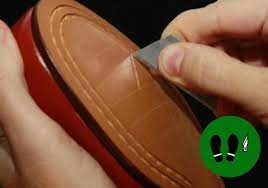 To make shoes non-slip for work, you may use a simple instrument like a metal nail file. You don’t need to go out and purchase this tool specifically since you probably already have it in your house. This technique is comparable to the sandpaper scraping technique I mentioned before.
To make shoes non-slip for work, you may use a simple instrument like a metal nail file. You don’t need to go out and purchase this tool specifically since you probably already have it in your house. This technique is comparable to the sandpaper scraping technique I mentioned before.
In comparison to sandpaper, a metal nail file might be more efficient since it is robust, has better control because of its grip, and has a well-defined pattern.
Here’s how to use this technique to mend slick shoes and make them non-slip.
- Hold the footwear firmly.
- To determine whether parts of the shoe’s bottom are softer or smoother, run your palm over it.
- The smoother sole surface should now become rough as you use the metal nail file over those places.
- Note: Using a coarser nail file can make slipping-resistant shoes with less effort and better results possible.
- Fixing slick shoes by scoring the soles
Also Read: Can You Resole Boat Shoes
Scoring the Soles
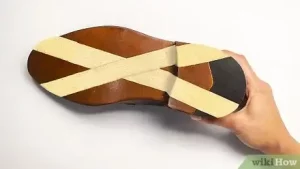 This is another easy, quick, and effective tip for making your shoe slip-resistant for the office. Since this method requires using a knife, razor, or another sharp item on your beloved shoes, you may be hesitant to use it. But trust me when I say that after using this method, you won’t regret it.
This is another easy, quick, and effective tip for making your shoe slip-resistant for the office. Since this method requires using a knife, razor, or another sharp item on your beloved shoes, you may be hesitant to use it. But trust me when I say that after using this method, you won’t regret it.
Here’s how to use the scoring process to give work shoes a non-slip sole without sacrificing their quality.
- Holding your shoes securely, place them upside-down on the table.
- You should carefully carve shallow, angular lines on the sole of your shoes using a razor blade or a penknife with a sharp knock.
- Making a lattice-like design on the bottom of the shoes will improve their appearance and increase their traction.
- Note: Using this technique to increase traction on rubber soles has been proven successful.
- Adding Traction and Making Shoes Slip-Resistant Using a Grip Pad
Using a Grip pad
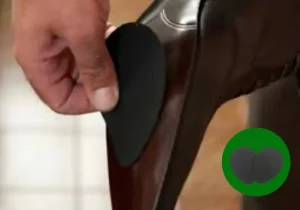 You may use this technique to make your worn-out shoe non-slippery. When you wear the same pair of shoes for a lengthy period of time and the bottoms start to wear out, you may apply this technique. It is comparable to how a fresh car tire has distinct, visible treads. This kind of situation may be seen in shoes with rubber outsoles that lose their tread pattern after prolonged ground contact.
You may use this technique to make your worn-out shoe non-slippery. When you wear the same pair of shoes for a lengthy period of time and the bottoms start to wear out, you may apply this technique. It is comparable to how a fresh car tire has distinct, visible treads. This kind of situation may be seen in shoes with rubber outsoles that lose their tread pattern after prolonged ground contact.
You may be considering getting go of your beloved pair of worn-out sneakers. Don’t worry; I’ve discovered an affordable and practical remedy that can give traction to the sole of shoes and restore their slip-resistant properties for just a few dollars. High-quality textured grip pads with adhesive backing are available to improve traction in the shoe heel region. Grip pads include an adhesive side for attaching them to the bottom of the shoe and a durable, rough side.
Some gripping surfaces are designed to attach to any pair of shoes. These may be adjusted on the soles’ ball of the foot and heel with relative ease. On my wish list, UrChoice non-skid shoe pads are at the top. Other grip pad possibilities include ones that are sufficiently big to be cut to suit any kind of footwear. You may see them from this location.
Here are the procedures for applying non-slip shoe pads.
- To make it simple to attach grip pads, first use some rubbing alcohol on a clean cloth to remove all the dirt, mud, and dust from the bottom of the shoes.
- Remove the grip pad’s protective covering and adhere it to the desired area of the shoe’s soles.
- To make sure the adhesive agent of the pad is properly positioned onto the sole, press the pad firmly into the sole and let it sit for at least 24 hours.
- Note: To strengthen the bonding, warm the pad’s adhesive region with the hairdryer. To achieve this, put the pad on your hand and cut off the adhesive part before using a hairdryer to blast warm air through it for one to two minutes.
Also Read: Why Do People Wear Shoes in the House
Fix Slippery Shoes by Spraying Anti-Slip Agent
In addition to grip pads, non-slip coating sprays are also available to improve the slide resistance of the soles and repair slick shoes. Spray pads are another name for them. Grip spray is a quicker—though somewhat more expensive—way to make shoes non-slip than waiting for a day for the grip pads to set. The spray has an adhesive chemical component that improves grip by creating a sticky surface on the sole’s chosen location.
You may apply the grip spray using the same method as we did with the grip pads. You must first use a clean towel dampened with rubbing alcohol to wipe the sole. Use the spray next to the sole’s smoother areas, such as the heel and ball of the foot. Put on the shoes after you wait a little while. You’ll notice that shoes now have more traction.
Remarkably messy, this technique for making shoes non-slip. Make careful to shield everything in a workspace from a towel or newspaper, including the uppers of your shoes, the floor, your clothes, and other items. Additionally, remember to put on the mask before spraying to shield yourself from its effects.
There are several varieties of spray pads. To prevent your shoes’ quality from being harmed, you should constantly strive to get the greatest spray.
Apply a Salt and Rubber Cement Mixture
Each technique we’ve described aims to improve shoe traction by increasing grip to the bottom. You must think the author is completely bonkers for recommending putting glue and salt solution on your pricey shoes. I know this method looks a little strange, but it has worked for my shoes. When salt is added to glue, the mixture takes on a granular texture that increases grip by giving shoes’ bottoms a rough finish.
Applying this procedure has the benefit of having a long-lasting impact on the bottom of the shoes, making them less likely to slide.
The steps for using this approach are essentially the same.
- First, use rubbing alcohol to wipe the shoes’ bottoms.
- Make a thin solution of glue and a few salt grains in a basin.
- Apply the glue salt paste with a brush to the sole’s concentrated areas.
Finally, give the shoes some time to dry.
How to Make Shoe Non-Slip for Work | Video Explanation
FAQs
How can I know whether a pair of shoes are slip-resistant?
Verifying that the bottoms are composed of sturdy, slip-resistant rubber and embedded with grooves or lugs in a certain pattern is the best way to determine if the shoes are slip-resistant or not. The majority of slip-resistant soles are constructed of rubber or nitrile.
I analyzed the top 22 shoes for comfort, safety, and slipping resistance in my post on the best shoes for industrial work. You’ll notice that every pair of shoes has a strong construction and bigger lugs on the rubber bottoms for increased traction.
Similarly to this, in my post on the best shoes for nurses, I examined both casual and athletic work shoes that nurses, cooks, and restaurant staff may wear to give outstanding slip-resistant. You can see that the soles of the shoes have grooved treads in a certain pattern to make them non-slip for work.
Why do we wear non-slip shoes?
As I said above, some startling statistics demonstrate how catastrophic injuries from slips and falls have happened in the past, resulting in thousands of fatalities. Therefore, when buying non-slip shoes for your job, slip resistance is the most important factor to consider.
Also Read: Why Do Shoes Disintegrate And Crumble
Conclusion
So, here are all our tried-and-true tips for making shoes non-slip for work. It would be advisable to be close to a cobbler as these people are specialists in their industry and can make shoes slip-resistant with their excellence if you are worried about ruining the quality of the shoes since you are not an expert to deal with the shoes.
I really hope you will find all of the advice and suggestions presented in this post to be worthwhile enough to use. Please leave any further questions in the comment area below. Using my knowledge, I’ll attempt to respond to your questions satisfactorily. If you wish to shield your family and friends from serious slip-and-fall accidents, don’t forget to share this information with them as well.

Hi, I am Brian, Lives in Mooresville, North Carolina, and Went to The University of Texas at Austin, I am a shoe lover & know the inside out of shoes. I am well aware of the qualities of top-quality boots. That’s what I’m sharing with the reader of About Shoes/boots/footwear. Read More Here